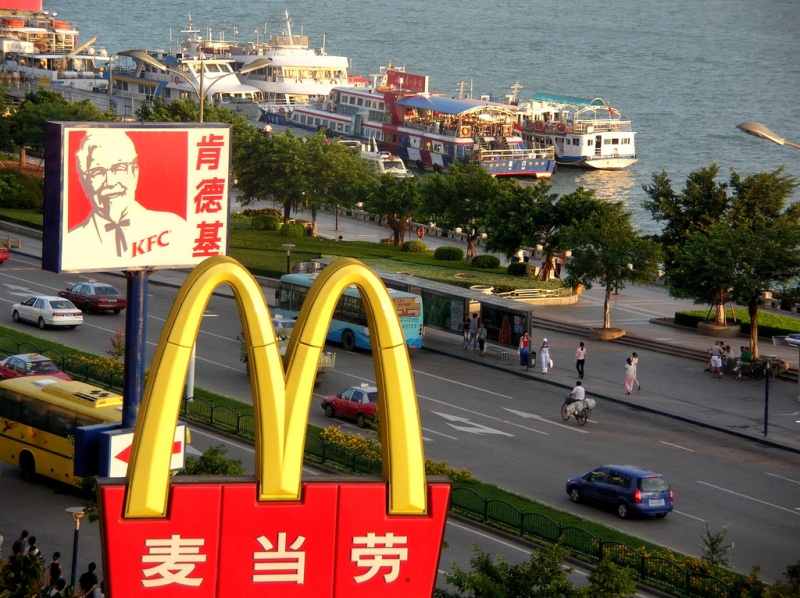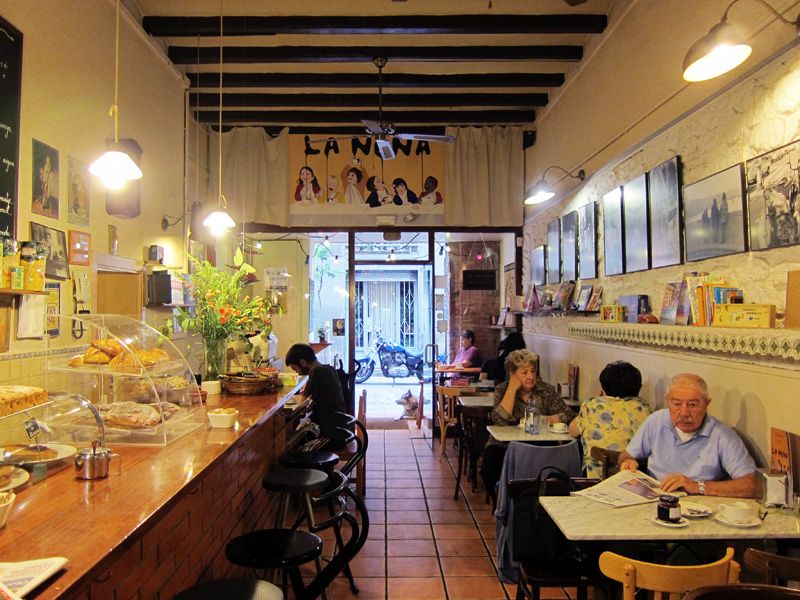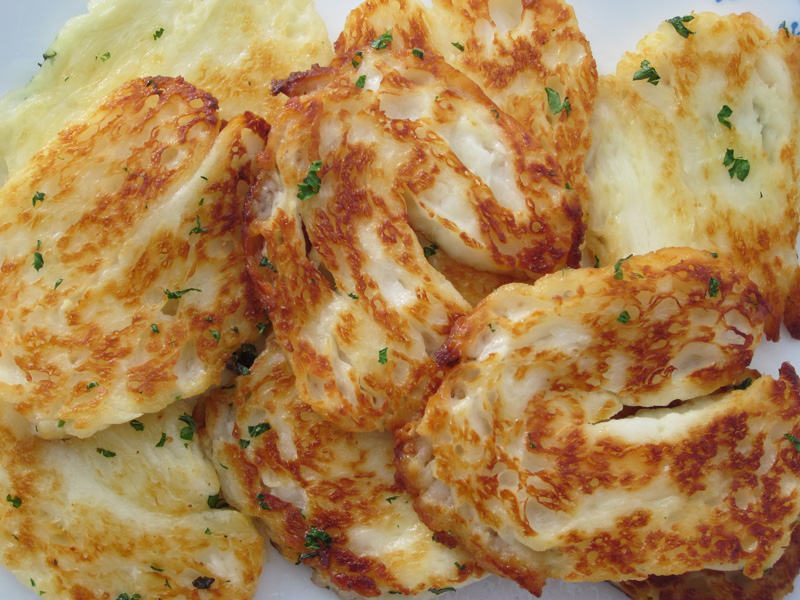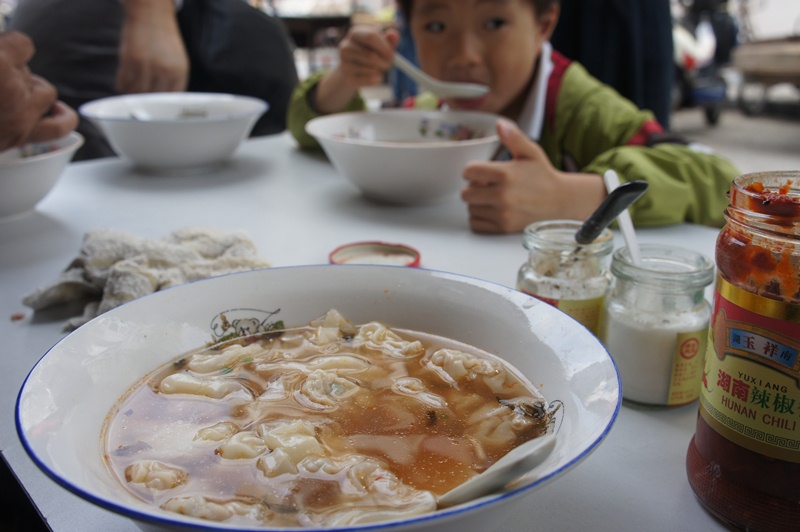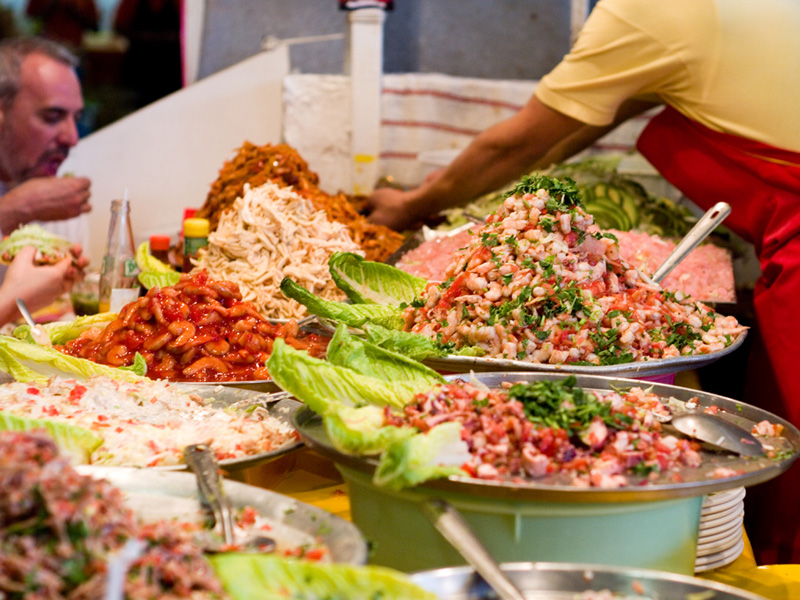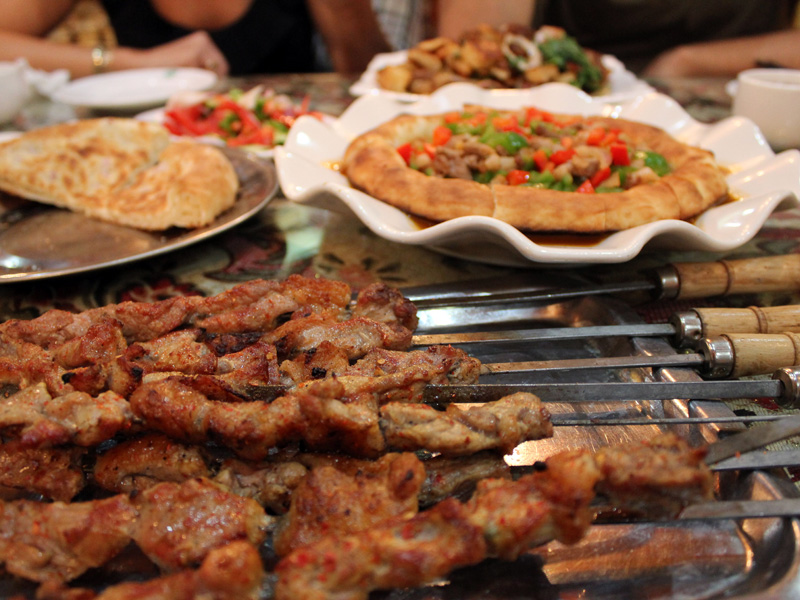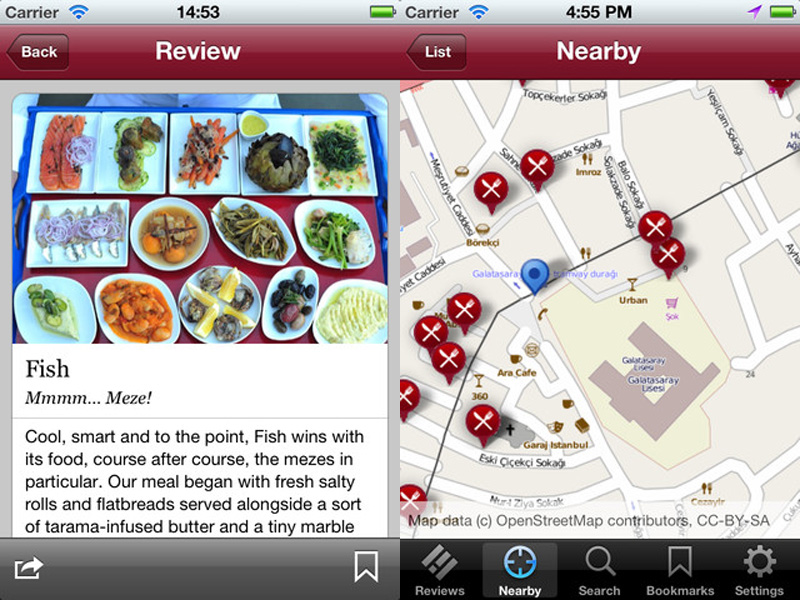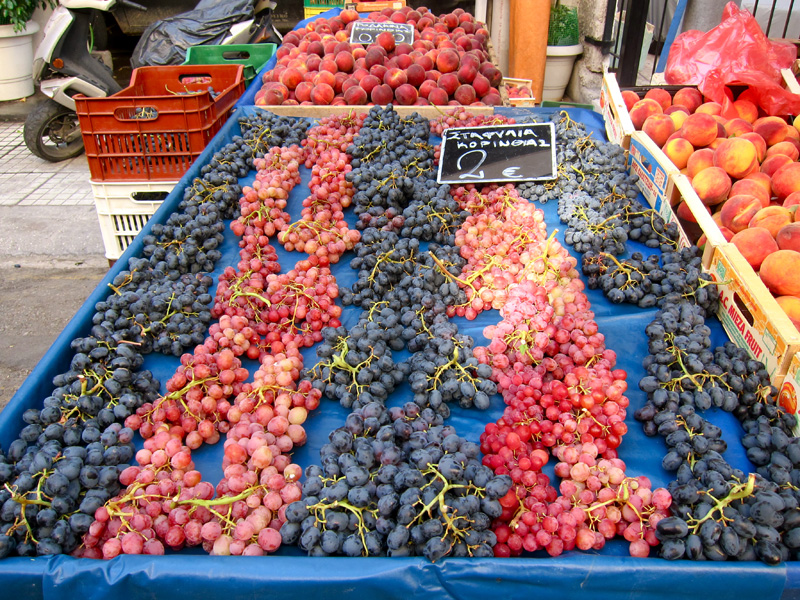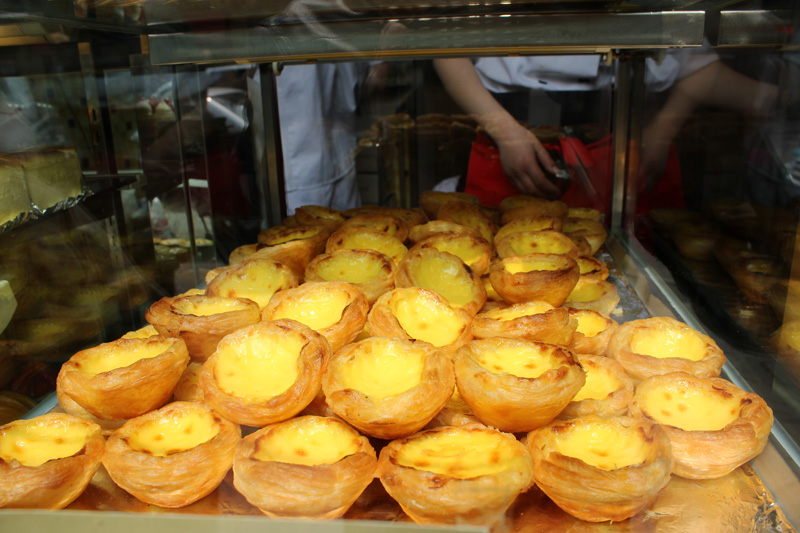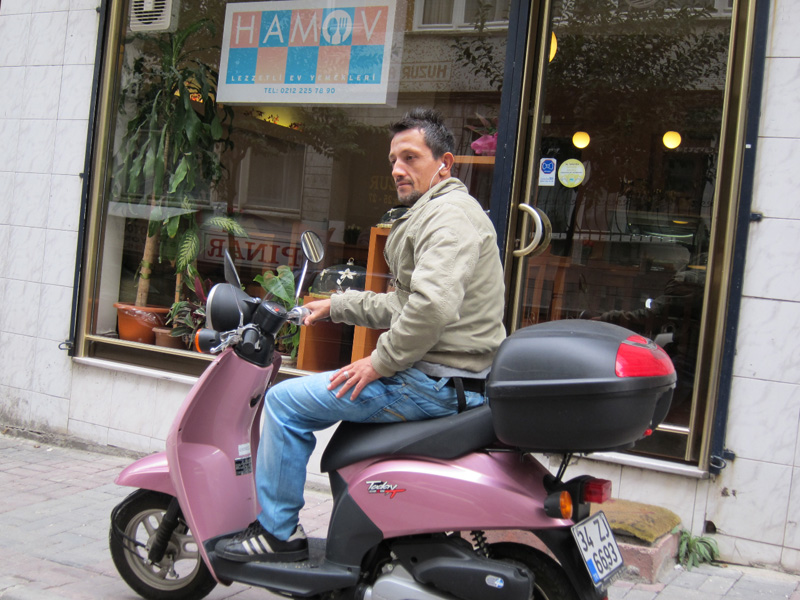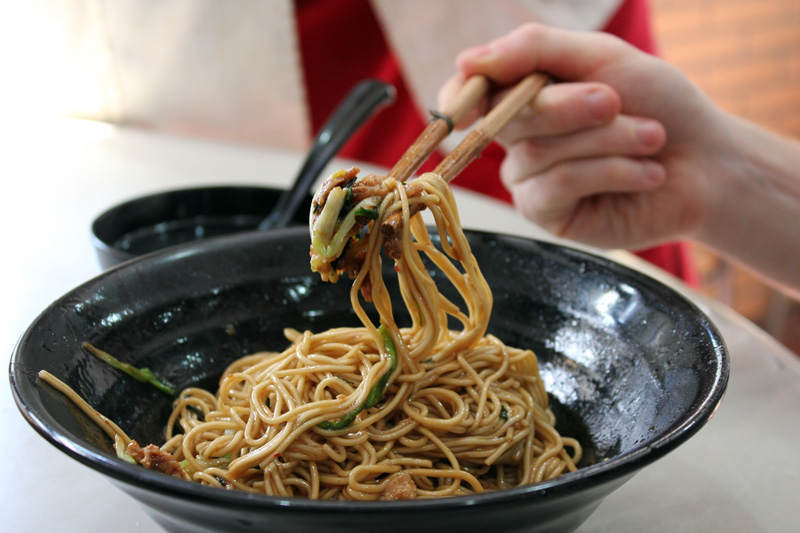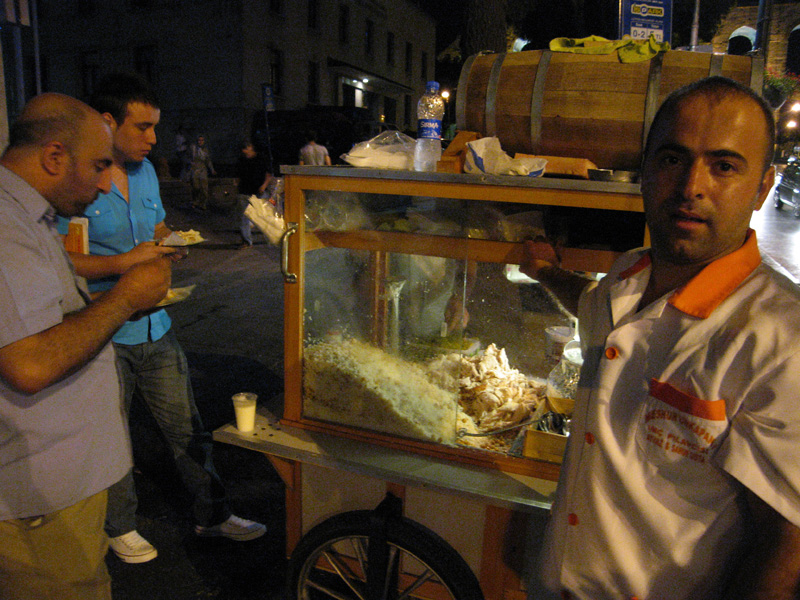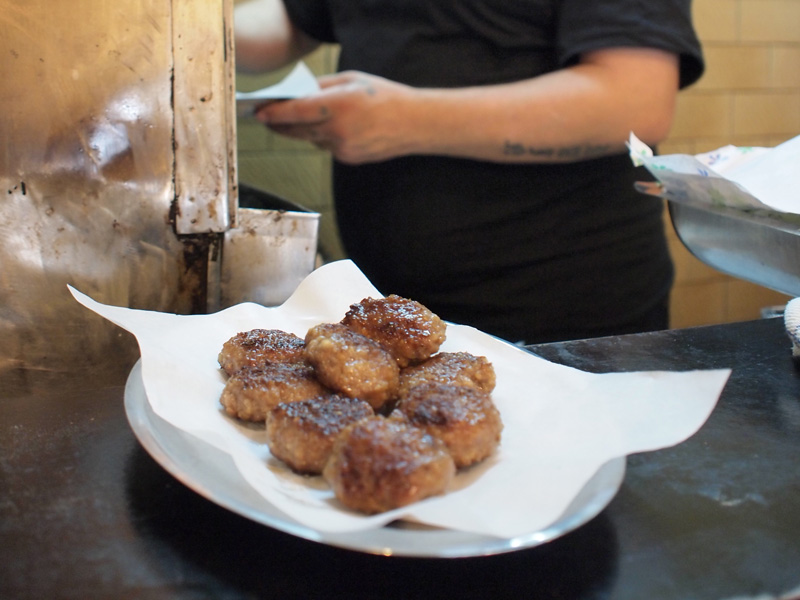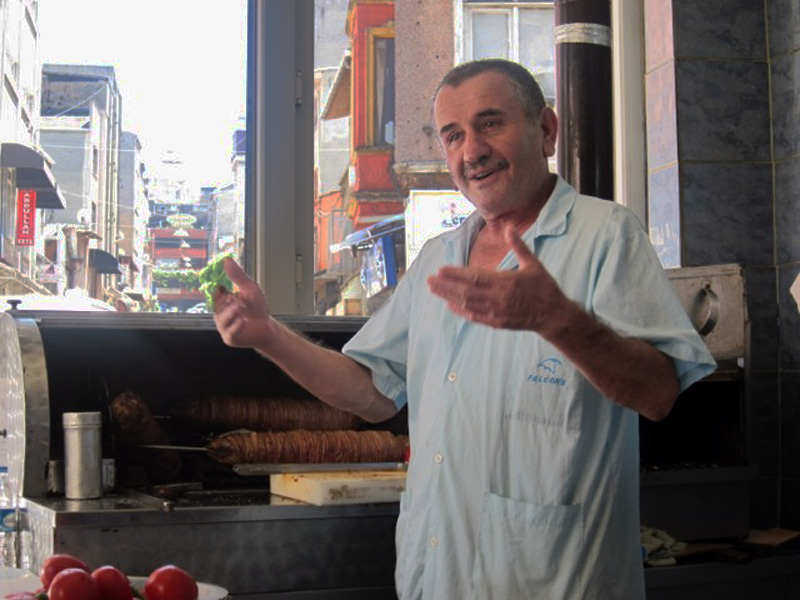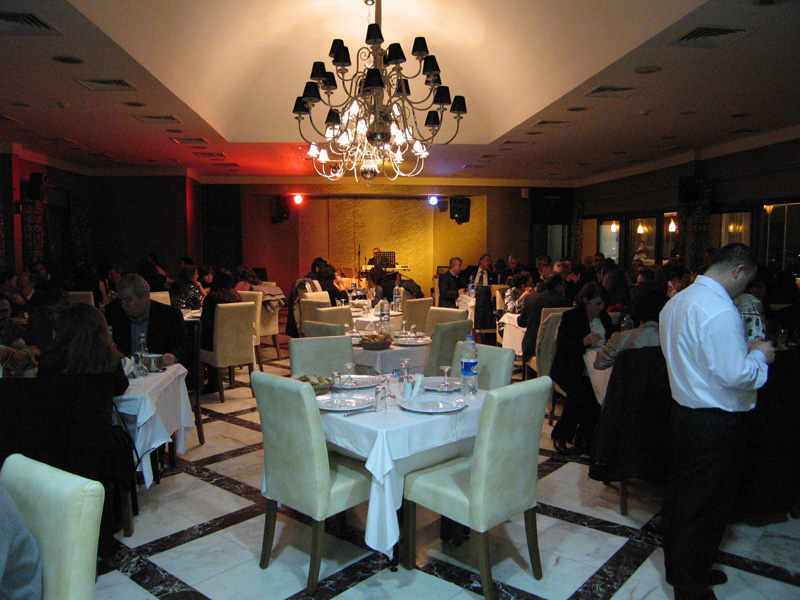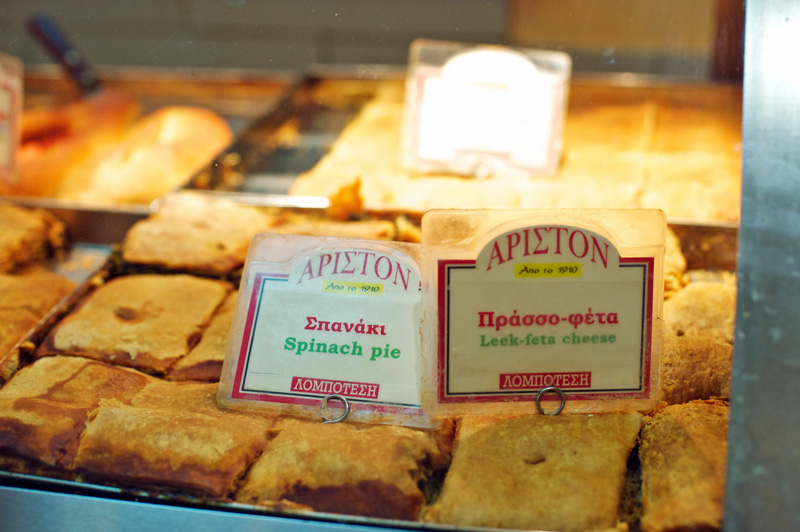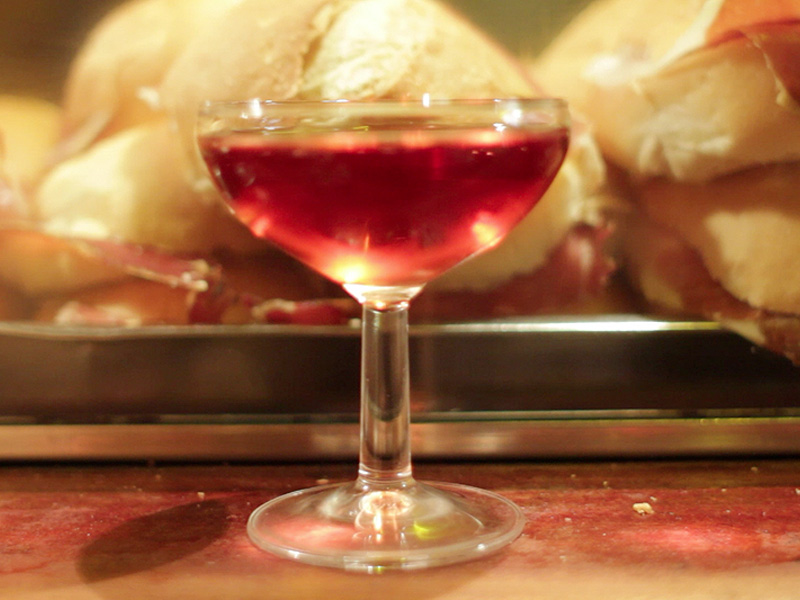We can't find the internet
Attempting to reconnect
Something went wrong!
Hang in there while we get back on track
Search results for
Shanghai
China’s Breakfast of Champions vs. The Egg McMuffin
Breakfast in China traditionally consists of something brothy and stomach-filling, such as congee (a rice-based porridge), wonton soup or xiǎolóngbāo (soup dumplings). Also popular are savory fried foods like scallion oil pancakes – in Shanghai, lines of hungry customers waiting to get their morning pancake fix from places like A Da Cong You Bing can literally stretch around the block. It’s thus no surprise that Western-style grab-and-go breakfast options are of little appeal to locals.
Read moreBarcelona
La Nena: Gràcia’s Sweet Temptation
The large banner in La Nena chocolatería proclaiming “No Hay Alcohol” (strung up between a rocking horse and a wooden toy kitchen) makes it fairly clear that this is not a place for sophisticated conversation and cocktails. That doesn’t mean that La Nena (which means “The Girl” in Catalan) doesn’t cater to any other vices. Indeed, its delicious homemade cakes, pastries, hot chocolates and savory snacks tempt the residents of Barcelona’s Gràcia neighborhood on a daily basis.
Read moreAthens
Turning Up the Heat on Halloumi
The rubbery, white Cypriot cheese known as halloumi in Greek and hellim in Turkish is without a doubt the island’s most famous culinary delicacy. Served grilled or fried, it has long been popular at tables in Athens, Istanbul and around the region. As demand from Western Europe and even North America has increased in the last decade, exports have shot up. But a new law regulating what goes into the cheese threatens to throw the industry into turmoil.
Read moreIstanbul
Klemuri: Black Sea Lazmatazz
Like Clark Kent hiding his Superman tights beneath a brown suit and glasses, Klemuri maintains the appearance of a predictable Beyoğlu café – wooden tables, shelves loaded with knickknacks, Buena Vista Social Club on the stereo, spinach crepes and a crispy chicken salad on the menu. But down in the kitchen, out of public view, Klemuri’s alter ego – a spry Laz cook – is waiting to save you from another boring “café” lunch.
Read moreIstanbul
In Istanbul, Staying One Meal Ahead of the Wrecking Ball
There’s nothing like a debate about “urban renewal” – often touted by municipal governments as a way to repurpose run-down urban areas for gentrification – to work up a good appetite. In a city like Istanbul, a teeming metropolis of 15 million people working to build a modern life among ancient ruins, these discussions seem to occur on every corn
Read moreShanghai
Lao Shanghai Sanxian Xiao Huntun: Little Shop of Wontons
There is often some confusion when it comes to the many varieties of dumplings in Shanghai. The city’s most famous snack, xiǎolóngbāo, is a soup dumpling that neatly encases its broth inside a thin dumpling skin. It is not, as many first-time visitors assume, a dumpling floating in soup. For that, we turn to the humble wonton soup.
Read moreIstanbul
İsmet Baba: Great Fish for Goodfellas
Diners in Istanbul are spoiled with options for fresh seafood. But most venues are mere caricatures of places like İsmet Baba, where traditions have been kept sacred for more than 50 years. While many other such restaurants are kitschy, İsmet is gritty and authentic. Located in Kuzguncuk, a charming neighborhood on the Asian side of the Bosphorus, it may not be the best restaurant in the city, but it’s got something most of the others have lost: old-school Istanbul charm and character.
Read moreIstanbul
Şimşek Pide Salonu: It’s Better with Butter
Turkey’s take on the pizza comes in two distinct varieties. There’s the Arabesque lahmacun, a round, ultra thin-crusted snack topped with a shmear of finely ground meat and seasoning. Then there’s pide, a more substantial canoe-shaped creation that’s a specialty of Turkey’s Black Sea region.
Read moreAthens
Derlikatesen: Neo Souvlaki
Don’t be fooled by the name: Derlikatesen does not stand for dirty and delicatessen, as online urban dictionaries would like you to think, but is a combination of “delicatessen” and the Greek slang verb ντερλικωνω (derlikono), meaning eating until one is ready to burst.
Read moreShanghai
Dongbei Siji Jiaozi Wang: The Dumpling King
With a menu from the frigid provinces that border Korea, Dongbei Siji Jiaozi Wang – literally, “The Four Season Dumpling King from the Northeast” – is all about hearty dishes to warm you up from the inside out. The further north you head from the Yangtze River, the more the temperate climate demands that wheat trumps rice as the staple grain, often showing up on menus as dumplings and noodles. Yet despite its eponymous claim to represent China’s Northeast, not even the Dumpling King can escape Shanghai’s astringent influence, specifically in the condiment selection. Here you dunk your boiled dumplings in vinegar and sweet chili pepper rather than the typical Northern garnish that adds soy sauce to the mix (or sometimes boldly goes it alone with no vinegar), occasionally coupled with roughly chopped garlic.
Read moreMexico City
Corazón de Maguey: Mezcal Goes Upscale
The sap of the spiky maguey plant has long been used by the indigenous peoples of Mexico to prepare pulque, a milk-colored, viscous drink that has roughly the same alcohol content as beer. When they arrived in Mexico, the Spanish were introduced to pulque. Used to imbibing harder stuff, however, the conquistadors experimented with distilling a mash made out of the maguey plant, in the process inventing the beguiling spirit known as mezcal. Previously a liquor considered the province of the poor and working classes, mezcal has in recent years become one of the trendiest and most popular alcoholic drinks in Mexico, with more than 150 different brands now on the market. (Tequila, made from blue agave – a kind of maguey – and produced within a specific region of Mexico, is the best-known member of the mezcal family.) The rise in mezcal’s popularity has led to a proliferation of mezcalerías, wine bar-like spots that specialize in pouring the drink. In Mexico City in particular, mezcalerías have popped up in nearly every neighborhood, and their numbers keep growing.
Read moreMexico City
Mexico City: State of the Stomach
Editor's note: This week, Mexico City joins Culinary Backstreets as our fifth city. We're delighted to launch Culinary Backstreets: Mexico City and look forward to sharing our culinary discoveries in this captivating metropolis. The vast megalopolis of Mexico City is one of the most misunderstood and misrepresented cities in the world. Adventurous tourists are often surprised to discover a vibrant national capital filled with incredible architecture, beautiful weather and amazing food. In some ways, this scene has been playing out for 500 years.
Read moreIstanbul
Köfteci Arnavut: On the Good Ship Meatball Shop
Perhaps it’s the proximity of the waters of the Golden Horn or the weathered wood interior, but we get a distinctly maritime feeling at Köfteci Arnavut, a tiny köfte joint in the historic Balat neighborhood. The members of the İştay family, who opened the place in 1947, seem to think the same thing, running the place with ship-shape efficiency.
Read moreShanghai
Lanzhou Lamian: Noodles With Pull
Is there anything that warms the heart of a food-obsessed traveler more than civic pride in a local culinary specialty? In a country that more often celebrates a particularly polarizing political leader, the great affection among the people of Lanzhou for their famous noodles – which the city has reportedly even sought to trademark – gets our stomachs rumbling.
Read moreAthens
The Chops Shops of Downtown Athens
If there is a symbol of the adoring relationship that Greeks have with lamb, it is none other than the lamb on a spit that most Greeks in mainland Greece eat as a specialty on Easter Sunday. Greeks eat beef or pork at least once per week; lamb, however, is not an everyday thing but a treat, something more than just meat.
Read moreShanghai
Xinjiang Expedition: The Three States of Naan
The three states of naan may not have any political standing, but they do enjoy culinary representation at one of Shanghai’s finest Uighur restaurants, Xinjiang Yining Yuanzheng, aka Xinjiang Expedition. We’re talking bread without borders, dough diversity at its finest, and a refreshing change of pace from the Chinese staple grains of noodles and rice.
Read moreBarcelona
La Plata: Pride (In the Name of Fresh-Fried Love)
If La Plata is good enough for Paul Hewson, it’s good enough for everyone. More commonly known by his stage name, Bono, Mr. Hewson ate here in June 2009 a few nights before kicking off U2’s 360° world tour at Camp Nou in Barcelona.
Read moreIstanbul
Kebapçı İskender: Delicious, By Law
A visit to Bursa İskender Kebabı® feels as if you’ve stepped right into the war room of the İskenderoğlu family’s never-ending quest to establish ownership over the İskender kebab, a plate of döner laying on a bed of cut flatbread doused with tomato sauce and butter and served with a scoop of cool yogurt on the side. The tables and walls of the restaurant are covered with literature about what the owners see as their family’s inheritance, but the rest of the world seems to consider public domain.
Read moreIstanbul
The Grand Bazaar Eats: Come for the Shopping, Stay for the Food
We like to think of Istanbul’s Grand Bazaar – open since 1461 – as the world’s oldest shopping mall. If that’s the case, shouldn’t the Grand Bazaar be home to the world’s oldest food court? That may be taking the analogy too far, but for us, the Grand Bazaar can be as much a food destination as a shopping one. As we see it, one of the hidden pleasures of going to the bazaar (once you get past the overzealous shopkeepers hawking souvenirs) is exploring some of its quieter back alleys and interior courtyards for new dining possibilities, especially some of the smaller restaurants that cater not to tourists but rather to the locals who work in the sprawling marketplace. Here are some of our favorite places.
Read moreShanghai
Yu Xin: Comfortably Numb
One of China’s most ubiquitous culinary exports, Sichuan cuisine is famous for the 麻辣, or málà (mouth-numbing spice), that comes in the form of a peppercorn (花椒, huā jiāo). Prompting a tingling sensation that has been likened to licking a nine-volt battery, the lemony husk is tossed into dishes with dried chili peppers, and never more skillfully than at Yu Xin.
Read moreAthens
Paradosiako: Traditional Values
Ah, the joys of Plaka! That most beautiful of Athens neighborhoods, full of sights for visitors to behold: Neoclassical buildings, views of the Acropolis and the Parthenon, tourist trap restaurants full of plastic, overpriced food. Joking aside, by all means go to Plaka, walk around, laugh at the kitschy copies of Ancient Greek statues depicting men with priapic erections. Then walk back to Syntagma and eat at Paradosiako.
Read moreIstanbul
Fatih Karadeniz Pidecisi: Crunch Time
Inside Fatih Karadeniz Pidecisi, nothing could be heard over the crunch and crackle of fresh pide being torn open and chomped down on. Still, the man across the table from us spoke in a low, conspiratorial whisper: “There are some very well-known businessmen sitting at that table by the window. They all come here,” he said.
Read moreShanghai
Mid-Autumn Mooncakes: The Stuff of Legend
Mid-Autumn Festival (中秋节, zhōngqiūjié) lands on the fifteenth day of the eighth lunar month, relatively near the autumnal equinox; in 2012, it falls on September 30. Also sometimes called Mooncake Festival, it is a public holiday in China and Taiwan on which families gather to give offerings to the full moon, float sky lanterns and eat mooncakes (月饼, yuèbing). A culinary tradition with legendary roots, mooncakes are sold everywhere from grocery stores to five-star hotels and come with competing origin stories that relate how these sweets came to represent the holiday.
Read moreIstanbul
An App Now on Our Menu!
For almost a year we’ve been sorting through comments and suggestions from readers of IstanbulEats.com to help us develop the ultimate iPhone application for eating locally and authentically in Istanbul. We know Istanbul is a tough city to navigate, so our app’s mapping system will steer you to your destination lunch with GPS. With the “Nearby” feature, you’ll find the kebab, mantı or baklava nearest to you all over the city.
Read moreAthens
Colibri: Winning Grecian Comfort Food Formula
Colibri constitutes something of an Athenian phenomenon: what started out as a small neighborhood pizza and burger takeout place in Mets, next to Athens’ grand First Cemetery, has now evolved into three successful restaurants where people actually queue for more than half an hour to eat homemade pizzas and burgers. The menu is the same in all three places, offering simple comfort food at decent prices.
Read moreIstanbul
Café Niko: Goodbye, Lari
In a desk drawer at Istanbul Eats HQ is an envelope of leftovers from days when life was less sedentary: Tajik somoni, Kyrgyz som, Cypriot pounds, a wad of Macedonian denar and a small stack of Georgian lari. As with the last bite on the plate, it’s impossible to throw money away, no matter how unstable the currency. But the real value of having it on hand is that it makes a return visit seem likely, even pending. Our plans to return to Georgia were made, cancelled, rescheduled and cancelled again. It would seem our lari would never be much more than a filthy little memento, an IOU from the National Bank of Georgia for a khachapuri that would never be cashed in.
Read moreAthens
Indian Spices: From Exotic Luxury to Student Fare
The so-called “ethnic” cuisines – from Middle Eastern and Indian to Chinese and Japanese – came to Athens relatively late, in the mid-1980s, and were a costly affair. Athens’ first “exotic” restaurant, the Kona Kai in the Athens Ledra Mariott Hotel, opened its doors in 1984 and was one of the city’s most fashionable, high-class restaurants for years, serving Polynesian cuisine. It remains untouched, at least in terms of décor: the venue is a glorious extravaganza of bamboo and waterfalls!
Read moreAthens
Move Over, Ouzo
During her travels this summer, Culinary Backstreets’ roving photographer seemed quite taken with the luscious-looking grapes she saw in Athens street markets (pictured). While Greek grapes are not just for eating – this is, after all, the land of Dionysus, the ancient god of wine – in modern times the aniseed-flavored spirit ouzo has been the country’s most popular alcoholic drink, with wine lagging far behind. Yet Greek wines, including those made from indigenous grape varietals, have recently begun attracting greater interest.
Read moreShanghai
Lillian Cake Shop: The Egg Tart, Perfected
Confucius once said, “The superior man is modest in his speech, but exceeds in his actions.” He clearly never met a food writer, because superlatives and immodest speech are basically all we have to work with. But had Confucius opened a small patisserie, it would probably be Lillian Cake Shop.
Read moreIstanbul
Hamov: Truth in Advertising
Around lunchtime, the phone at Hamov never stops ringing. The little pink delivery scooter and its tireless driver stay in perpetual motion in order to feed a neighborhood full of loyal customers good, home-style lunches where they seem to prefer it – in their homes. But Hamov is not just a delivery place; its small dining room fills up quickly, so we suggest arriving on the early side of the lunch rush to get the most out of Hamov.
Read moreIstanbul
Sultanahmet Dining Secrets: Where Locals Dare to Go
Call it the Sultanahmet Squeeze: How to stay close to the monuments of the Old City yet avoid eating in tourist traps? We get asked this question a lot. Since the Sultanahmet area is primarily a tourism zone, locals-only haunts are few and far between. At most restaurants, prices tend to be higher than usual, while quality and service are unreliable at best. That said, there are some fine places to eat in the area. We’ve compiled a short list of restaurants to help you avoid the traps.
Read moreBarcelona
Horchatería Sirvent: Nectar of the Gods
Be it kvass in Russia or boza in Turkey, every nation seems to have one of their own, a locally loved drink that to most outsiders comes off as a particularly strange brew. In Spain, that drink is horchata, a unique and deliciously refreshing concoction made from chufas (tigernuts), water and sugar. Served chilled, horchata is beloved all over the peninsula.
Read moreShanghai
Lao Difang: Oodles of Noodles
Does anyone say “use your noodle” anymore? Our grandparents used to admonish us with that idiom when we didn’t think a situation through, but the phrase seems to have mostly gone out of fashion along with polyester suits. However, deep in the former French Concession, one esteemed food vendor is definitely using her noodle to help her customers enjoy, well, noodles.
Read moreIstanbul
Meşhur Unkapanı İMÇ Pilavcısı: The (Rice) Freaks Come Out at Night
Late one night, zipping down a busy Istanbul thoroughfare in a taxi on our way home from the airport, we passed an intriguing scene. Huddled around a brightly lit food cart was a large group of men stuffing their faces in a kind of zombie-like frenzy. It almost looked like a scene out of Night of the Living Dead. What were they eating?
Read moreAthens
Peinirli: It Came from the Black Sea
Peynir means cheese in Turkish and peinirli (derived from the Turkish word peynirli, meaning “with cheese”) is a delicacy adored by pretty much everyone in Greece that strongly resembles the Turkish pide. It is a boat-shaped bread that is high in yeast and butter, with a buttery, cheesy filling.
Read moreIstanbul
Köfteci Hüseyin: The Cadillac of Meatballs
In New York, consider the pizza. You’ve got Famous Ray’s Pizza, Ray’s Original Pizza, World-Famous Original Ray’s Pizza, and so on. Ray and his imitators just wouldn’t bother if New Yorkers believed pizza was “just a slice.” It’s the same story in Istanbul with köfte, a dish that to non-locals may seem like nothing more than grilled meatballs, but which Turks take very seriously.
Read moreIstanbul
Ali Usta Kokoreç: Gut Master
Recently, while continuing our research into how kokoreç (grilled lamb intestines) became a fast-food staple in Istanbul, we were told by our favorite kelleci (vendor of cooked sheep’s head), Muammer usta, about one of the oldest kokoreç masters around. Ali usta’s shop is in Dolapdere, down the hill from the Tarlabaşı Sunday market and just past a large plane tree that is a neighborhood landmark, standing among tiny workshops, furniture depots and decrepit old residential buildings.
Read moreAthens
Doris: Detail Oriented
Housed in a bright pink neoclassical-style building on bustling Praxitelous Street (a road full of shops selling electrical equipment, wholesale beads and jewelry supplies), Doris has been around since 1900. It’s a traditional Athenian eatery known as a mageireio, which roughly means “cooking house” or “eating place.”
Read moreShanghai
Soup Dumplings: An Investigative Report
Any Shanghai denizen who has lived in the city for longer than a few months worships at the altar of xiǎolóngbāo (小笼包). These steamed buns of goodness – tiny pork dumplings with a slurp of soup wrapped up in a wonton wrapper – provide delicious fodder for debates among Shanghai’s fiercest foodies.
Read moreBarcelona
Viena: Fast-Food Kitsch
Viena is the love child of an Austrian ski lodge and a McDonald’s. This Catalan fast-food joint – which has become an obligatory foodie stop thanks to New York Times food writer Mark Bittman, who famously wrote that Viena’s flauta de jamón ibérico was the best sandwich he’d ever had – dishes up fast and delicious grub with a side of kitsch.
Read moreIstanbul
Beyoğlu Öğretmenevi: The Teacher’s Lounge
Like Atatürk statues and crescent-and-star flags etched into the sides of mountains, the öğretmenevi (“teacher’s house”) is an integral part of the Turkish landscape. Found in almost every city in Turkey, these government-run institutions serve as affordable guesthouses for educators on the road and – since anyone is welcome if space is available – for those traveling on a teacher’s budget.
Read moreAthens
Ariston: The Savory Pie Kingdom
Greece has a fantastic tradition of pie-making. Most Greeks have memories of their granny making some sort of pie in a big pan for the family to share. Savory pies are sold in individual portions in bakeries (which are everywhere in Athens) and sandwich shops, or even whole and frozen in supermarket freezers, much like pizza is sold in the U.S.
Read moreIstanbul
Hacı Beşir Usta: The Raw and the Hooked
At Istanbul Eats HQ, the conversation comes up every once in a while about how çiğ köfte has emerged as a sort of fast-food franchising opportunity: young entrepreneurial types are opening up çiğ köfte joints in all sorts of neighborhoods in Istanbul these days. Which, we all agree, is pretty cool. Rather than opening up a KFC or an Orange Julius in the food court, the ambitious souls of Turkey more commonly open up a raw-meatball stand instead.
Read moreAthens
Food Trucks, Part 1: The Dog Nights of Athens
In a city that stays up as late as Athens, it’s no surprise that late dinners and even later-night snacking are big. People don’t go out to dinner before 9 p.m., and most restaurants serve food up until midnight every night. Plenty of places are up and running till the early hours, or even all night long.
Read moreShanghai
Cha's: The Diner from Hong Kong
Hong Kong native and Cha’s owner Charlie Lau became a restaurateur because of a hankering. A movie producer by day, Lau came to Shanghai with Ang Lee to film “Lust/Caution,” and was disappointed that Shanghai lacked a proper Hong Kongese cha canting, a casual all-day eatery that serves traditional Cantonese food alongside milk teas and coffee. So he decided to open his own. On the set of “Lust,” a 1930s period piece, Lau was responsible for ensuring the historical accuracy of the costumes, casting and set design, so it’s not surprising that he designed Cha’s with the past in mind. Walking across the restaurant’s threshold transports you to 1950s Hong Kong.
Read moreBarcelona
Can Paixano: Dive In
Can Paixano, the kind of timeless dive that could soon be extinct due to the rise of Western chains, is an obligatory stop for anyone wanting to taste a slice of the real Barcelona. And the bar’s location in Barceloneta, the traditional fishermen’s quarter where the old port meets the beach, provides the perfect setting.
Read more